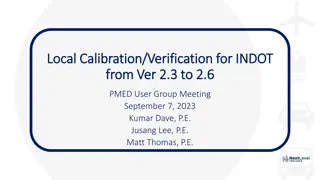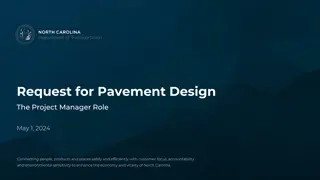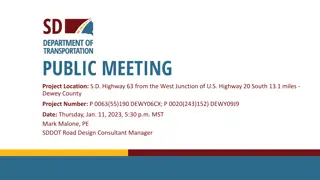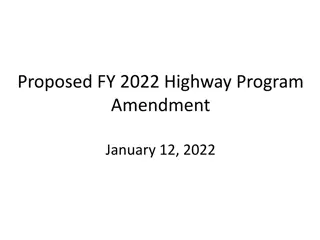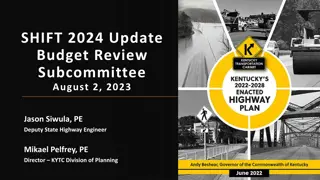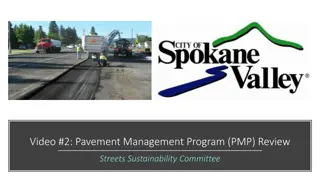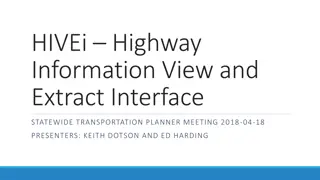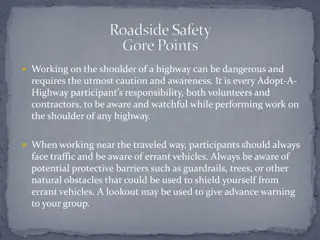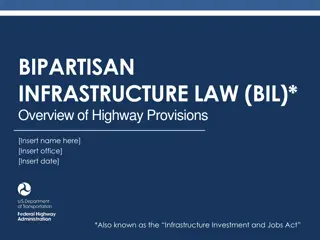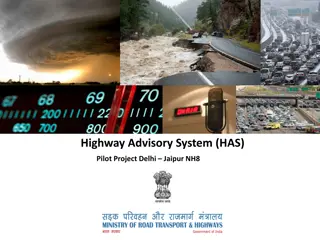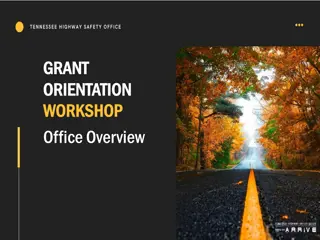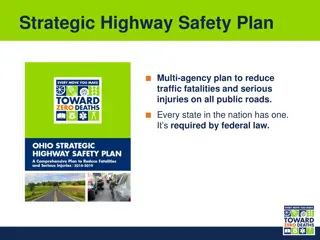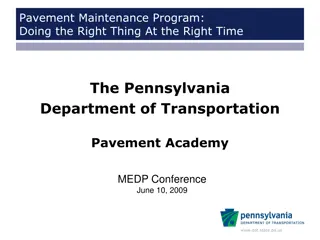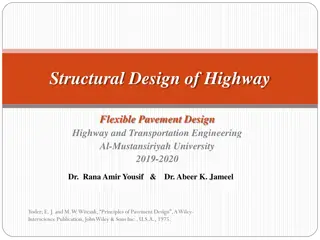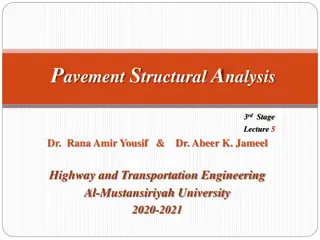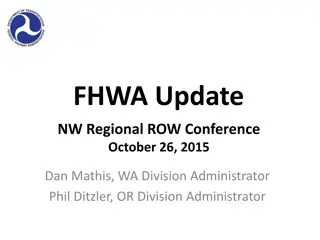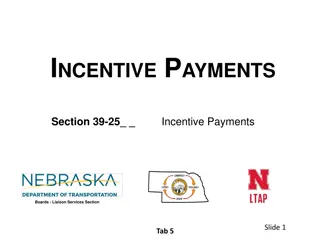Local Calibration and Verification for INDOT - PMED User Group Meeting
This presentation highlights the local calibration and verification process for the Indiana Department of Transportation (INDOT) from Version 2.3 to 2.6. The session covers the objectives, data collection, processing, and analysis conducted by Kumar Dave, Jusang Lee, and Matt Thomas. INDOT's key fac
1 views • 29 slides
Rigid Pavement Design: Stresses and Joint Types
Stresses due to temperature variation can affect concrete slabs, causing warping and friction stresses. Proper joint design, including expansion, contraction, and construction joints, is crucial to minimize stress and prevent warping in concrete pavements. This guide explores different types of join
4 views • 9 slides
Request for Pavement Design
Seeking Pavement Design services in North Carolina for safe and efficient connectivity. Requests for designs go to Shihai Zhang, with specific criteria for projects to go through the Pavement Review Committee. Information needed includes project details, traffic data, and plans.
0 views • 4 slides
Public Meeting for S.D. Highway 63 Improvement Project in Dewey County
Public meeting scheduled for Thursday, Jan. 11, 2023, at 5:30 p.m. MST to involve the community in planning and designing improvements for S.D. Highway 63 in Dewey County. The meeting aims to gather input on the proposed project, project limits, background information, traffic data, crash history, h
0 views • 23 slides
Principles of Traffic Demand Analysis and Highway Demand Forecasting
Understanding traffic flows is crucial in designing highways and managing traffic effectively. Traffic demand analysis involves forecasting future traffic volumes, modeling demand, and determining the necessary infrastructure improvements. This analysis helps in estimating axle loadings, pavement th
0 views • 36 slides
AASHTO Method for Highway Flexible Pavement Design
The AASHTO method for highway flexible pavement design is based on the AASHO Road Test results and has been revised over the years to provide guidelines for pavement structural design. It emphasizes performance period, time constraints, and design variables to ensure long-lasting and cost-effective
1 views • 25 slides
Safety Best Practices in Construction & Materials Conference - Harold Mullen Texas Asphalt Pavement Association
This content highlights safety best practices shared by Harold Mullen during the Texas Asphalt Pavement Association's 2021 Construction & Materials Conference. It emphasizes the importance of wearing PPE, being vigilant on the job site, obeying road safety rules, and spreading awareness to prevent r
0 views • 13 slides
Proposed FY 2022 Highway Program Amendment Summary
The Federal Infrastructure Bill, Infrastructure Investment and Jobs Act (IIJA) was passed, providing $550 billion in funding for transportation. The bill includes reauthorization of surface transportation programs from FY 2022 to FY 2026. Changes to projected funds for FY 2021 projects and adjustmen
0 views • 8 slides
Geometric Design of Highway Vertical Curves and Criteria
This content covers the vertical alignment in transportation engineering, focusing on the geometric design of highway facilities, specifically vertical curves like crest and sag curves. It explains the main design criteria for vertical curves, including minimum stopping sight distance provision, dra
2 views • 24 slides
Guidelines for Design of Cement Concrete Pavement and Interlocking Paver Blocks
This document provides guidelines for designing cement concrete pavements and interlocking paver blocks, covering factors governing design, wheel loads, design period, subgrade characteristics, approximate k values based on CBR values, and the importance of a sub-base below concrete pavements. It em
0 views • 67 slides
Understanding Asphalt Binders in Pavement Construction
Asphalt binders play a crucial role in pavement construction, composed of three types of hydrocarbons: asphaltenes, resins, and oils. Different types of asphalt cements are produced for specific applications, such as liquid asphalts and asphalt emulsions. Quality control tests ensure the performance
0 views • 16 slides
Kentucky's Highway Plan Development and Improvement Overview
Kentucky's highway plan involves capturing needs and translating them into projects, with a focus on larger highway improvement projects like safety improvements, road widening, reconstruction, new interchanges, and routes. The process includes project development planning to address operational and
0 views • 6 slides
Understanding Pavement Management Programs: A Comprehensive Overview
Discover the intricacies of a Pavement Management Program (PMP) through a detailed review presented to the Streets Sustainability Committee. Explore the historical practices, recent advancements, and key elements of the City's PMP. Learn about 450 centerline miles, street classifications, budget con
0 views • 28 slides
Influence of Seasonal Temperature on Pavement Reliability Performance: A Case Study
This case study explores the impact of seasonal temperature changes on pavement reliability performance (PRP) by analyzing crash and pavement data for three pavement types in a U.S. State, delving into how temperature affects asphalt properties and friction levels. The study compares crash trends fo
0 views • 26 slides
Comprehensive Highway Data Extraction Interface - HIVEi Overview
Explore HIVEi, a platform for extracting highway information data efficiently. Discover features like District Transportation Plan Maps, Public DataMart resources, and detailed data extraction options covering roadway, pavement, traffic, bridge, and more.
0 views • 16 slides
Pavement Engineering Overview: Types, Design, and Requirements
A comprehensive overview of highway pavement engineering, covering types of pavements, structural requirements, ideal pavement characteristics, and classifications into flexible, rigid, and composite pavements. Proper pavement design is crucial for ensuring long-lasting, safe, and high-quality road
0 views • 19 slides
Introduction to Rigid Pavement Design in Highway Engineering
Rigid pavements, made of cement or reinforced concrete slabs, are designed to resist traffic loads by distributing them over a wide area of soil. The design focuses on providing a structurally strong concrete slab. Minor variations in subgrade strength have little impact on rigid pavement capacity,
0 views • 13 slides
Advanced Highway Information Extraction Interface
Explore the HIVEi highway information extraction interface presented at the Statewide Transportation Planner Meeting in 2018. Learn how to select and extract data on highway systems, roadway features, pavement conditions, traffic information, bridges, and more. Discover the detailed process and capa
0 views • 14 slides
Roadside Safety Gore Points: Highway Work Caution
Working on highway shoulders requires utmost caution and awareness due to the dangers posed by passing traffic. Participants must always face traffic, be vigilant of potential obstacles, and avoid entering gore points. These traffic decision points demand extra attention as motorists enter or exit h
0 views • 5 slides
Subarea and Highway Corridor Studies: Travel Demand Modeling and Refinements
In this lesson, we delve into subarea and corridor studies focusing on travel demand model refinements, highway network coding, corridor congestion relief, and trip assignment theory. Subarea modeling plays a crucial role in forecasting travel within smaller regions with detailed traffic patterns, t
1 views • 45 slides
Bipartisan Infrastructure Law - Overview of Highway Provisions
This presentation provides an overview of the highway provisions in the Bipartisan Infrastructure Law (BIL), also known as the Infrastructure Investment and Jobs Act. It focuses on significant programs and provisions related to highways, offering insight into budget authority, contract authority, ob
0 views • 73 slides
Chapter 1 Study Guide: Driving, Mobility, and Highway Safety
Explore the comprehensive study guide for Chapter 1, covering topics such as driver education benefits, personality's impact on driving, car insurance insights, mandatory insurance in New Jersey, and the role of the National Highway Safety Act in ensuring road safety. Delve into the potential conseq
0 views • 9 slides
Governors Highway Safety Program Overview
The Governors Highway Safety Program (GHSP) in Vermont has undergone a change in venue, now operating under the newly established Highway Safety Office at the Agency of Transportation (AOT). This strategic restructuring aims to enhance collaborative efforts and streamline highway safety initiatives
0 views • 48 slides
Highway Advisory System (HAS) Pilot Project for Safer and Faster Travel on NH8
The Highway Advisory System (HAS) Pilot Project on the Delhi-Jaipur NH8 aims to provide real-time information on congestion, weather conditions, safety awareness, and disaster warnings to ensure safe and hassle-free travel on National Highways. The project encompasses phases focusing on construction
0 views • 9 slides
Tennessee Highway Safety Office Overview & Funding Details
The Tennessee Highway Safety Office (THSO) plays a crucial role in implementing statewide programs focused on highway safety, including occupant protection, impaired driving, speed enforcement, and more. Established in 1967, THSO administers federally-funded programs following the federal fiscal yea
0 views • 16 slides
Ohio State Highway Patrol - Images Collection
Explore a collection of images showcasing the Ohio State Highway Patrol. From official vehicles to officers in action, these images capture the essence of the Ohio State Highway Patrol's work and dedication. Scroll through to get a visual glimpse of this law enforcement agency in action.
0 views • 9 slides
Nevada Department of Transportation Overview
The Nevada Department of Transportation (NDOT) is responsible for the planning, construction, operation, and maintenance of the state highway system, which includes over 5,400 miles of highways and 1,000 bridges. NDOT is funded through state highway funds and federal funds without utilizing any gene
2 views • 16 slides
Selection of Layer Thickness in Highway Flexible Pavement Design
Selection of layer thickness for highway flexible pavement design involves determining an initial pavement structure's design structural number and then choosing appropriate thicknesses to meet or exceed the required structural number. Cost-effectiveness, construction constraints, and maintenance co
0 views • 11 slides
Strategic Highway Safety Plan Update 2020 Review
Strategic Highway Safety Plan (SHSP) is a multi-agency effort to reduce traffic fatalities and injuries on public roads, mandated by federal law. The plan must be updated every five years to utilize Highway Safety Improvement Program (HSIP) funds. Ohio Department of Transportation (ODOT) receives si
0 views • 8 slides
Effective Pavement Management Program Overview
This program by the Pennsylvania Department of Transportation focuses on the importance of implementing preventive maintenance strategies at the right time for highway pavement management. It covers topics such as types of pavements, preventive maintenance concepts, treatment selection, and timing f
0 views • 14 slides
Climate Models and Moisture Equilibrium in Flexible Pavement Design
Climate inputs like temperature and moisture play key roles in flexible pavement design. The heat transfer model evaluates frost action and temperature regimes, while moisture equilibrium models consider the interaction between soil suction and moisture content. Understanding these factors is crucia
0 views • 13 slides
Understanding Design Speed in Highway Engineering
Design speed in highway engineering refers to the selected speed used to determine the geometric features of roadways. It has evolved over time, with the current definition emphasizing safety, driver expectations, and balancing various factors like social, environmental, and economic considerations.
0 views • 12 slides
Comparison of Kentucky Highway Fatality Rates Across Multiple States
Analysis reveals Kentucky's highway fatality rates in comparison to other states over the years 2005, 2013, 2014, and 2015. Data from the National Highway Traffic Safety Administration (NHTSA) shows variations in fatalities per 100 million vehicle miles traveled, positioning Kentucky among the state
0 views • 29 slides
Transforming Dixie Highway Project Overview
The Transforming Dixie Highway project aims to address existing conditions on Dixie Highway, focusing on highway improvements, bus rapid transit, and intelligent transportation systems. Key components include crucial partnerships with transportation entities, extreme challenges such as physical cons
0 views • 13 slides
Nonlinear Analysis of Pavement Structural Stresses and Deflections
Explore the effect of nonlinearity in granular materials on vertical stresses and deflections in pavement structural analysis. Learn about iterative methods and stress invariants to understand pavement behavior under traffic loads. Discover the application of Boussinesq's solutions and Burmister's l
0 views • 20 slides
Overview of Nebraska County Highway and City Street Superintendents Exam Preparation
This content provides detailed information on the preparation for the exam for Nebraska County Highway and City Street Superintendents, including topics such as Highway Law, State Oversight & Support by Regulatory Boards, and the duties and responsibilities of the Board of Public Roads Classificatio
0 views • 11 slides
Federal Highway Administration Updates and Regulatory Processes Overview
This content covers updates from the Federal Highway Administration (FHWA), including the NW Regional Right-of-Way Conference in 2015, the federal rule-making process, agency regulatory updates, and changes in CFR regulations. It also discusses proposed highway bill reauthorization acts such as the
0 views • 16 slides
Incentive Payments and Distribution in County Highway Management
The information provided outlines the purpose, process, and factors involved in incentive payments for appointing licensed superintendents to manage road or street programs in counties. It details the conditional duties of appointed county highway superintendents and factors determining the amount o
0 views • 18 slides
Pavement for Cities: A Detailed Business Plan by DLS-Construction GmbH
This detailed business plan by Sascha Kindermann, Lothar Kunz, and Diana Hennings explores various aspects of pavement for cities, including calculations, advantages, disadvantages, financing, applications, and road construction. It covers the definition of pavement, its types, advantages like durab
0 views • 27 slides
Geometric Design Principles for Highway Routes
This content discusses the application of geometric design principles in highway route design, focusing on preliminary route layout, defining design controls, and establishing initial alignments. Key factors such as minimum radius of curves, vertical curve length, maximum grades, intersection approa
0 views • 28 slides
